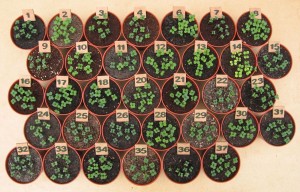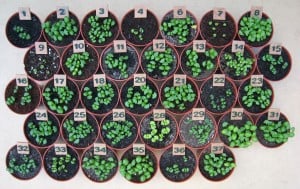Instead of giving any more time to the myths about sowing in peat-free composts, put them to the test. You’ll find they do the job as well as peat – without the ecological price-tag.
Of all the myths that abound in gardening, the most pernicious are surely those that circle our inevitable but painfully slow farewell to using peat in our seed and potting mixes. The move from using composts containing non-renewable and habitat-wrecking peat, to those made from more sustainable, truly renewable raw ingredients, is akin to pulling slugs’ teeth (blindfolded, with your hands tied behind your back). In no other area of gardening are fallacies and cock-and-bull stories recycled with such tedious regularity, or with such vigour.
So what is it with these falsehoods that keeps them going? It is perhaps no coincidence that alongside potting shed myths such as ‘all peat-free is rubbish’ we can now pick from a range of tried and tested peat-frees which are kinder on the world around us. A new peat-free compost, SylvaGrow, is being launched for gardeners in the UK, literally as I write, after quietly proving its mettle among commercial plant growers over many years.

One familiar myth was fondly retold recently on The Sun newspaper’s gardening page. After declaring ‘many’ composts to be ‘unfit for purpose’, it bemoaned ‘lumps’ in compost bags, and cited Which? Gardening’s 2013 trials which concluded that they couldn’t recommend any peat-frees (trials which, incidentally, seemed to get in a muddle which no one wants to talk about). The Sun’s response was, ‘Our recommendation remains – AVOID peat-free and low-peat composts’ (their emphasis). There then followed a puff-piece for several compost brands, some made of almost 100% peat, plus a ‘pleased to report’ ray of sunshine accompanying this call to keep on plundering nature’s carbon stores: ‘Last summer’s hot weather… gave a bumper harvest of peat.’
I don’t know anyone who would argue that peat composts don’t grow great plants – much of our horticultural heritage was founded on them. It’s also pointless to argue that peat-free composts have always been perfect: they haven’t – though their development has been hamstrung by myth-making and some shoddy, disappointing bandwagon products (sold even in big-name outlets). Nevertheless, to imply that peat compost is the only game on the potting bench is wrong, and it’s deliberately misleading.
The bogus reasons for not going peat-free are withering, but the myths supporting continued peat use are unlikely to dissolve quite so easily. The reasons aren’t hard to pin down: a varying mix of denial, ideology, lack of candour, ‘championing’ of an industry that deserves more rigorous challenge, and laziness. We can throw in a lack of empathy with the natural world, too. But the best way to mow down a gardening myth is to put it to the test – so let’s get started.

The myths about peat-free composts spurred me to put almost 40 of them through their paces in my eye-opening, garden-scale trials (for the full key see below). One of the most pervasive fables is that peat-free composts are simply no good for sowing seeds. The story is often peppered with tales of how these disease-infested mixtures of rubbish from our wheelie bins need so much sieving your arms will drop off (which overlooks the fact that not all peat-frees contain composted garden or ‘green’ waste). Funnily enough, I don’t know many gardeners without a sieve at their elbow, whether they’re using peat-based or peat-free. The act of sieving brings out our nurturing side, whether it’s necessary or not.
For my seed-sowing trial I used common mustard, basil ‘Sweet Green’ and white foxglove (Digitalis purpurea f. albiflora/‘Alba’). All the seeds were sown in clean 9cm diameter plastic pots and germinated either in my unheated greenhouse, or for the foxgloves, in shade outdoors. Each pot was overfilled with compost taken straight from the bag, tapped to settle, levelled and lightly firmed. The mustard and basil were then sown 10 seeds per pot using a DIY circular ‘sower’ with 10 evenly-spaced prongs, each 1cm long, making sowing identical in each pot. For the foxgloves, each pot of compost was topped with a 5mm sieved layer of that compost, and a small cap was used to measure out an equal number of seeds which were sown evenly over the surface.
The mustard and basil were watered with fresh tap water from a clean watering can with a fine rose; the foxgloves were stood in a clean tray of tap water to allow each pot to soak up moisture from below (to avoid disturbing the tiny seeds). Using clean pots and tap water reduced the risk of introducing harmful ‘damping off’ organisms, which can lurk in water butts; this meant that any such problems with the resulting seedlings were likely to have originated with the compost itself. The mustard and basil were germinated in my unheated, well-ventilated greenhouse, and watered individually on an as-needed basis. The foxgloves were germinated in shade outdoors, covered by a repurposed secondary glazing unit to protect them from heavy rain. Watering was done as needed, using a fine mist sprayer. You can see the results in these pictures; details of sowing date and when each photograph was taken are given in the captions.

Now tell me, on first glance, do any of these images (click them for a larger view) suggest seedlings struggling for survival in a pot of rat-ridden compost from hell? I thought not. What they show is a convincing myth-buster if ever there was one; they demonstrate that most peat-free composts (even those which under-performed in my other trials) can germinate seeds and produce healthy seedlings ready for potting up. Yes, there’s variability across the bunch, but this was down to little more than different levels of plant foods in each mix. Some were poor performers across all three sowings, such as Fair Trade Coir (7), which I discovered contained no nutrients (although the seeds still germinated). Foxgloves germinated on all of the composts, but failed to get a foothold on those whose surface dried quickly, and there was some damping off, mostly among the coir-based mixes (3, 4, 8, 9, 10). But each pot went on to produce ample seedlings. Are good-quality peat-free composts fit for the purpose of sowing seeds? Yes, they are.

There’s another old gardeners’ tale that my sowing trial inadvertently helped to demolish: that you can only grow decent plants in sterile (i.e. dead) compost that’s free of anything ‘harmful’. Take a peek at pot 12 in each picture, especially at the mustard and basil; they don’t look half bad. This compost was a 50:50 mix of worm-worked compost from my plastic bins, and mature leaf mould, both sieved. That was it. Yes, a few seedling weeds popped up, but the plants in my humble DIY mixture did better than those in some of the composts I’d bought.
Proof, if any were needed, that when you actually knuckle down and get modern and reliable peat-free composts under your fingernails – even those you mix yourself – you never know which myth will be toppled next…
Compost key (some of these may have been reformulated/discontinued since this trial in 2012. Only composts recommended for seed sowing were included):
1 B&Q Verve Multipurpose Peat-free; 2 Bullrush Professional Peat-free Multi-purpose; 3 Carbon Gold Biochar All Purpose; 4 Carbon Gold Biochar Seed; 6 Dobbies Organic & Peat-free Enriched; 7 Fair Trade Coir; 8 Fertile Fibre Multipurpose; 9 Fertile Fibre Seed; 10 Fertile Fibre Vegro Multipurpose; 11 Godwins Eco Supreme; 12 Home-made mix 1, 50:50 garden compost + leaf mould; 13 Home-made mix 2, 50:50 garden compost + coir; 14 Leaf mould; 15 Melcourt All-purpose Peat-free; 16 Miracle-Grow expand ’n GRO Concentrated Enriched; 17 Miracle-Gro Peat Free; 18 Nature’s Own Organic Vegan Multipurpose*; 20 Nature’s Own Seed and Cutting*; 21 New Horizon Coir Compost; 22 New Horizon Organic & Peat Free Multi-purpose; 23 New Horizon Organic & Peat Free Seed & Cutting; 24 Notcutts Peat Free Multi-purpose; 25 Petersfield Peat Free Multipurpose; 26 Premier Peat Free Multipurpose; 28 Rolawn Organic Multi-purpose; 29 Tolhurst Organic Produce Potting**; 30 Vital Earth Multi Purpose; 31 Vital Earth Multi Purpose + Added John Innes; 32 Vital Earth No 1 Seed; 33 Vital Earth RSPB Multi Purpose; 34 Vital Earth Seed & Cutting; 35 West+ Light & Easy Multipurpose; 36 Wildlife Friendly Peat Free Multi Purpose; 37 Wool Compost. *Made using reclaimed upland peat **Not available to gardeners
Text and images © John Walker


